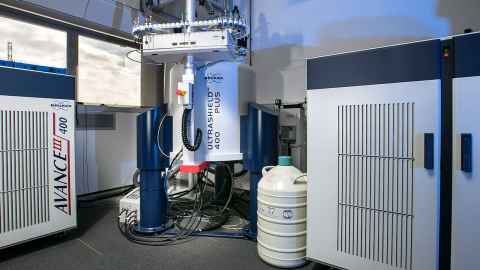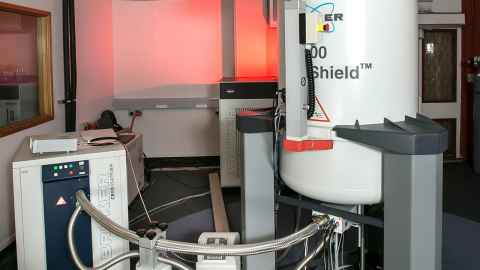Nuclear Magnetic Resonance Centre
Nuclear magnetic resonance spectroscopy is one of the main techniques used to obtain physical, chemical, electronic and structural information about molecules.
The University of Auckland's Nuclear Magnetic Resonance (NMR) facility provides access to both solid-state and solution-state NMR instrumentation.
Equipment
- NMR Spectrometer Bruker AV300
- NMR Spectrometer Bruker AVIII400
- NMR Spectrometer Bruker AVIII-HD500
- NMR Spectrometer Bruker Neo 600
NMR Spectrometer Bruker AV300
The Bruker AV300 Spectrometer operates at a 300.13 MHz proton Larmor frequency. The instrument has two RF channels with a pneumatically switched 1H-19F/31P/13C probehead and two double tuned magic-angle spinning probes with maximum spinning frequencies of 7 and 35 kHz (7 and 2.5 mm rotor size, respectively).
These are broadband, standard bore probes and they cover most common nuclei.
Applications for this spectrometer include obtaining routine 1H, 13C, 31P and 19F spectra of synthetic compounds, and multinuclear magic-angle spinning solid state NMR experiments on solid materials.
Specified sensitivity for a single transient is 170:1 (1H), 110:1 (13C), 130:1 (31P) and 200:1 (19F).
NMR Spectrometer Bruker AVIII400

Two Bruker AVIII Spectrometers operate at proton frequencies of 399.89 and 400.13 MHz, respectively. Both a three-channel and two-channel configuration is available.
The 399.89 MHz two-channel instrument is fitted with a 60-position sample changer, the 400.13 MHz three-channel instrument features a 24-position sample changer.
Both instruments utilize automatically tuned broad-band observe probeheads spanning the entire frequency range between 19F and 109Ag on the broadband channel.
One spectrometer operates in walk-up automation mode, the other is suitable for NMR experiments at varying temperatures between 300 to 380 K.
Applications for this spectrometer include obtaining routine 1H, 13C, 31P and 19F spectra of synthetic compounds, 1D and 2D structural studies of organometallic complexes, and multinuclear measurements for studying reaction kinetics.
Specified sensitivity for a single transient is 350:1 (1H), 220:1 (13C), 210:1 (31P) and 320:1 (19F) at 399.89 MHz, and 340:1 (1H), 180:1 (13C), 190:1 (31P) and 360:1 (19F) at 400.13 MHz.
NMR Spectrometer Bruker AVIII-HD500
The Bruker AVIII-HD 500 Spectrometer is configured as three-channel instrument with automatically tuned broad-band observe probeheads spanning the entire frequency range between 19F and 109Ag on the broadband channel for high-resolution NMR.
A cryogenically cooled probehead allows detection of 1H, 19F and 31P-15N with high sensitivity, as well as observing 19F-13C correlations. Two solid-state probeheads are available on this instrument. A double tuned 4mm magic-angle spinning probehead complements the capabilities of the 500 MHz instrument.
The triple-resonance 2.5mm magic-angle spinning probehead allows application of double cross-polarisation experiments, substantially extending the solid state methods portfolio.
The instrument is equipped with a 24-position sample changer and extended temperature range VT gas conditioning unit, allowing automated variable temperature experiments both in high-resolution and solid-state mode.
Applications for this spectrometer include obtaining routine 1H, 2H, 13C, 31P and 19F spectra of synthetic compounds, structural studies of organometallic complexes, study of mature derived polymers such as ethyl cellulose and chitosan, and solid-state NMR of organic and inorganic materials.
Specified sensitivity for a single transient is 800:1 (1H), 320:1 (13C), 200:1 (31P) and 600:1 (19F) (conventional probehead); 1600:1 (1H), 850:1 (13C), 510:1 (31P) and 1690:1 (19F) (cryogenic probehead).
NMR Spectrometer Bruker Neo 600

The Bruker Neo 600 spectrometer is equipped with an inverse (1H optimized) cryoprobe giving the ultimate in 1H, 13C and 2H sensitivity.
An inverse broadband detection probehead is also available for this spectrometer.
Applications for this spectrometer are primarily structural investigations of biomacromolecules, and protein-ligand interaction studies.
Access to the 600 MHz spectrometer is by appointment only. Users are not permitted to run their own experiments.
Specified sensitivity for a single transient is 6100:1 (1H), 1000:1 (13C).
Contact Dr Michael Schmitz directly to arrange experiments on this instrument.
How we can help you
For standard 1H/13C/31P/19F 1D and 1H-13C 2D correlation experiments: the user needs to provide an approx. 20+ mg or 50 uM (minimum for 9 kDa MW protein) sample in a suitable deuterated solvent and NMR tube.
For most protein applications: uniformly 13C/15N isotope-enriched protein samples are required.
Samples for University of Auckland clients are run by the user on the 300 MHz to 500 MHz spectrometers, with the exception of solid state NMR samples and samples to be run on the 600 MHz spectrometer. The required training will be given by the NMR Facility Manager.
Samples submitted by external clients may be run by user or NMR Centre staff at the client's discretion. These samples are to be submitted ready-made in solvent and NMR tubes.
For variable temperature experiments: these are typically run by user. If the exact range or list of temperatures is known in advance, this can be run under automation if the instrument workload permits. Solvent is to be DMSO-d6.
Other experiments may be arranged on request. We do not offer time-domain NMR, NMR relaxometry or related techniques.
Spectra and raw data will be returned by e-mail. Samples are to be collected at the end of the analysis otherwise they will be returned by courier or disposed of. In both cases, fees are likely to be charged. Data analysis and interpretation is not included – please arrange with a qualified School of Chemical Sciences academic.
- Booking of NMR instrument time is done through a web application by registered and trained NMR users only. (Booking and instrument access requires a University of Auckland login account.)
Our people
- NMR Facility Manager, NMR Spectroscopist | Dr Michael Schmitz